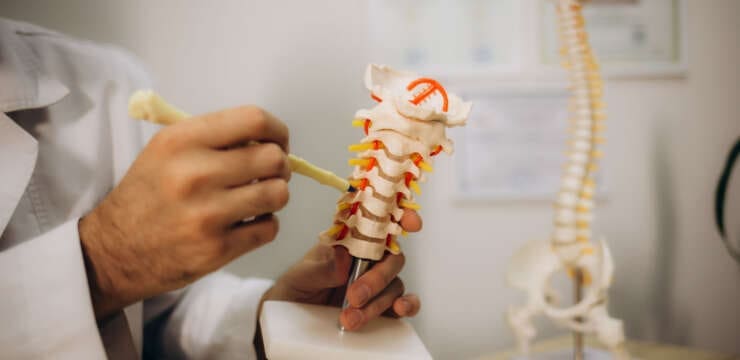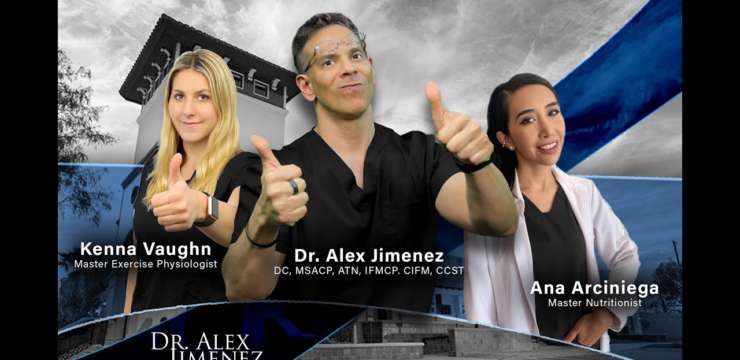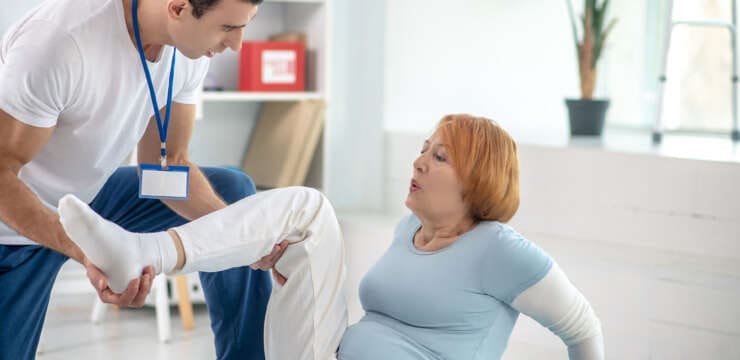
Table of Contents
How Head Injuries Can Trigger Sciatica—and How Integrative Chiropractic Care May Help

Overview
Sciatica is nerve pain that travels from the lower back or buttocks down one or both legs. Most people think of sciatica as a “low-back problem.” But head trauma—including concussions and moderate-to-severe traumatic brain injuries (TBIs)—can also set off changes that raise sciatica risk. Head injuries can alter how the brain controls spinal muscles, shift upper-neck alignment, increase systemic inflammation, and even trigger heterotopic ossification (new bone growth) that can compress the sciatic nerve over time (Safaz et al., 2008; Sullivan et al., 2013). In short, injuries “above” can create pain “below.” (This connection—TBI to downstream pain via spinal sensitization—has also been shown in animal and clinical research.) PubMed+2Cleveland Clinic+2
This article explains, in clear steps, how head injuries can lead to sciatica and how an integrative chiropractic approach—working in conjunction with medical care—may help realign the spine, calm irritated nerves, reduce inflammation, and support a steady return to function.
The brain–spine–sciatic nerve link after head trauma
a) Motor control changes can “pull” on the sciatic pathway
The brain constantly fine-tunes the tone of the muscles surrounding the sciatic nerve, including those in the spine and hips. After a head injury, descending pain-control circuits and motor programs can become dysregulated. Studies show mild TBI can drive spinal sensitization—a “turned-up” pain state—through serotonin and chemokine (CXCR2) signaling in the spinal cord, which can heighten back and leg pain even without a new lumbar injury (Sahbaie et al., 2019; Liang et al., 2017). Nature+1
When spinal stabilizers (multifidi, gluteals, deep rotators) fire out of sync, the pelvis can tilt, the sacroiliac joints can stiffen, and the sciatic nerve can be mechanically irritated as it passes through crowded tunnels in the hip and deep glute (piriformis region). Over weeks to months, this dysfunctional patterning can feel like “mysterious” sciatica that started long after the head injury.
b) Neck misalignment can cascade down the chain
Cervical misalignment—especially at the upper neck—often co-occurs with head injury. Clinical reviews note that head trauma and cervical issues frequently travel together, and that cervical spine injuries are more common when brain injuries are severe (Paiva et al., 2011). Mal-position of the atlas/axis can alter head posture, shift thoracic and lumbar loading, and increase tension along the dural and myofascial chains, adding stress around the sciatic nerve pathway. PMC
c) Systemic neuroinflammation increases pain signaling
After a TBI, inflammatory mediators rise in both the brain and spinal cord. Experimental studies show that mild TBI up-regulates CXCR2-related chemokines (CXCL1/CXCL2) and glial activation, promoting nociceptive sensitization—in other words, pain feels stronger and lasts longer (Sahbaie et al., 2019; Liang et al., 2017). That sensitization can amplify otherwise modest irritation along the sciatic nerve. Nature+1

Heterotopic ossification (HO): how new bone can squeeze the sciatic nerve
In some patients, TBIs trigger heterotopic ossification—abnormal bone growth in soft tissues. HO can form around the hips after head trauma and, in rare cases, physically entrap the sciatic nerve. One case report documented bilateral sciatic nerve entrapment from hip HO 17 months after a TBI (Safaz et al., 2008). Larger reviews estimate that 8%–20% of patients with TBI develop clinically significant neurogenic HO around joints (Sullivan et al., 2013). Cleveland Clinic also notes that HO risk rises after head trauma and other injuries (Cleveland Clinic, 2022). PubMed+2+2
Symptoms of HO near the hip can mimic or worsen sciatica, including deep aching, reduced hip motion, and nerve-like pain extending into the leg. When HO matures and compresses the sciatic nerve, patients may require a combined approach—conservative rehabilitation to maintain joint mobility and reduce pain, careful imaging, and, in select cases, surgical resection of mature HO to relieve entrapment (Issack et al., 2008; Sullivan et al., 2013). PMC+1
Why head and neck injuries raise the risk of back and leg pain
Head injuries rarely happen in isolation. Many patients also experience whiplash or torso impacts that load the cervical and thoracolumbar regions. Research shows that concomitant cervical spine injury is not unusual in moderate-to-severe TBI, and the upper cervical region is a common site (Paiva et al., 2011). That cervical dysfunction can drive maladaptive posture and breathing patterns, tighten paraspinals, and shift load to the lumbar segments and sacrum—fertile ground for sciatic irritation. PMC
Clinically, many concussion patients report “new” low-back or leg symptoms during recovery. Chiropractic and rehab clinics that treat post-concussion patients describe this neck-low-back connection, emphasizing upper-cervical assessment, vestibular rehabilitation, and graded return to activity. While these clinic reports are not randomized trials, they align with the broader neuro-musculoskeletal pattern observed after head injuries (Broadview Health Centre, 2023; Precision Chiropractic, 2025). Broadview Spine & Health Centre+1
How integrative chiropractic care may help—step by step
Important: Chiropractic care should not replace emergency or medical management of TBI. Think of it as a supportive, musculoskeletal-focused layer within a coordinated plan that includes medical oversight, physical therapy/vestibular rehab, and lifestyle care.
a) Assess alignment and motion, from the atlas to the ankle
An integrative chiropractor will start with a comprehensive history and neuro-orthopedic exam, including gait, balance, cervical and lumbar motion, sacroiliac mobility, hip rotation, hamstring tension, and neural tension tests (e.g., straight-leg raise). When needed, they’ll coordinate imaging to evaluate red flags (fractures, severe disc herniation), and, for persistent or progressive deficits, refer to neurology or orthopedics.
b) Gentle, targeted spinal adjustments
The goal is to restore segmental motion where joints are fixated and calm overactive segments that are compensating for them. After TBIs, this often focuses on the upper cervical spine (to reset head-to-neck mechanics) and the lumbopelvic complex (to reposition the pelvis so that the gluteals fire correctly). Early relief often comes from decreased joint irritation and improved muscle recruitment patterns around the sciatic pathway. Clinical programs and practice pages describe reductions in neck-driven low-back irritation and improvements in movement following careful realignment (Apex Chiropractic, 2022–2023; Pinnacle Health Chiropractic, n.d.). Apex Chiropractic+2Apex Chiropractic+2
c) Modulating neuroinflammation and sensitization—indirectly
Realignment and movement re-education can reduce peripheral nociceptive input, which may indirectly calm central sensitization. Animal studies show that chemokine/serotonin-mediated spinal sensitization contributes to pain after TBI (Sahbaie et al., 2019; Liang et al., 2017). While spinal manipulation has not been proven to directly alter those pathways, decreasing mechanical drivers (such as pelvic torsion, facet irritation, and hamstring guarding) can lower the overall “threat” level and enhance the effectiveness of other therapies. Nature+1
d) Supporting CSF and blood flow: what we know and don’t know
Some clinics propose that restoring cervical alignment may improve cerebrospinal fluid (CSF) or blood flow. Patient-facing resources describe this concept, but rigorous trials are limited. It’s reasonable to frame this as adjunctive: alignment and gentle mobility work may support comfortable movement and autonomic balance, which many patients interpret as “clearer head” and steadier recovery (Apex Chiropractic, 2022; Pinnacle Health Chiropractic, n.d.; Dr. Jimenez’s clinical summaries). Apex Chiropractic+2pinnaclehealthchiro.com+2
e) Exercise therapy: build the scaffold that protects the sciatic nerve
A progressive plan usually mixes:
-
Breathing + core activation (diaphragm, lower abdominals) to reduce lumbar shear.
-
Hip-hinge and gluteal re-training (bridges, hip abduction) to unload the piriformis and deep rotators around the sciatic pathway.
-
Nerve mobility (gentle sliders/gliders) when appropriate—avoiding aggressive stretching early on.
-
Balance/vestibular drills for post-concussion instability that otherwise forces the low back to “brace.”
This kind of plan is common in post-concussion rehab programs described by integrative clinics (Broadview Health Centre; MetroHealth). Broadview Spine & Health Centre+1
f) When HO is suspected
Red flags include progressive stiffness, palpable bony masses near the hip, and worsening nerve symptoms months after the initial injury. Providers coordinate imaging (X-ray/CT) and specialty referrals. Reviews and case reports describe surgical removal of mature HO as a last resort for sciatic entrapment, usually after a period of rehabilitation and medical management (Issack et al., 2008; Sullivan et al., 2013; Cleveland Clinic, 2022). PMC+2+2
Dr. Alexander Jimenez’s integrative perspective (El Paso)
At Dr. Jimenez’s clinics in El Paso, integrative teams combine gentle spinal adjustments, functional rehabilitation, and nurse practitioner oversight. The focus is on posture, balance, and lumbopelvic control after head and neck injuries, with close attention to red flags that warrant imaging or specialty referral. Clinic articles emphasize that while some practitioners discuss possible CSF-related benefits of cervical alignment, patients should treat these as supportive concepts alongside established rehab and medical care (Dr. Jimenez, 2025). elpasobackclinic.com+2El Paso, TX Doctor Of Chiropractic+2
A simple, safe progression you can bring to your care team
Always individualize with your clinicians. If you have red-flag symptoms—rapidly worsening weakness, bowel/bladder changes, fever, cancer history, trauma—seek urgent medical care.
Week 0–2 (calm the storm):
-
Gentle cervical and lumbopelvic adjustments as cleared by your clinician
-
Supine diaphragmatic breathing, abdominal bracing (10–20 breaths, 2–3×/day)
-
Isometric glute sets; short, flat walks tolerable without symptom spikes
-
Vestibular nods/eye-tracking drills if you have balance/visual strain
Week 2–6 (re-pattern and load):
-
Side-lying clamshells, bridges, hip hinge with dowel, step-ups
-
Nerve sliders (under guidance) if neural tension is present
-
Light carries (contralateral suitcase carry) for anti-rotation control
-
Progress walking to intervals; begin low-impact cardio as cleared
Week 6+ (resilience):
-
Romanian deadlifts with light load, split-squat progressions
-
Single-leg balance + head turns; dynamic stabilization work
-
Return-to-activity plan that respects post-concussion exertion thresholds
When to escalate care
-
HO concerns: stiff, enlarging masses near the hip; worsening nerve pain months after TBI ? imaging referral.
-
Progressive weakness or sensory loss in a dermatomal pattern ? urgent medical evaluation.
-
Persistent central pain features (widespread sensitivity, sleep disturbance, mood changes) ? coordinated pain medicine, psychology, and rehabilitation medicine.
Key takeaways
-
Head injuries can indirectly cause or worsen sciatica by disturbing motor control, shifting cervical–pelvic alignment, and heightening spinal pain signaling. PMC+1
-
Some TBI patients develop heterotopic ossification around the hip that can physically compress the sciatic nerve; this requires coordinated medical care. PubMed+1
-
An integrative chiropractic plan, nested within medical management, aims to realign the spine, improve movement, and reduce mechanical factors that contribute to sciatic irritation—while respecting red flags and evidence-based limits around CSF-related claims. Apex Chiropractic+2pinnaclehealthchiro.com+2
Practical FAQ
Does every concussion cause sciatica?
No. But concussions can change neck mechanics and pain signaling, which raises the odds of low-back and leg symptoms—especially if you also had neck or trunk strain.
Can chiropractic “fix” CSF flow?
Some clinics report symptom relief, attributing it to improved CSF or blood flow after cervical alignment. Evidence here is early; use this concept as an adjunctive, not a stand-alone promise. Pair alignment works in conjunction with rehabilitation, sleep, nutrition, and medical oversight. Apex Chiropractic+1
When should I get imaging?
If you have red flags (rapidly worsening weakness, numbness in a saddle pattern, bowel/bladder changes, fever, cancer history, or trauma), seek medical care fast.
How long until I feel better?
Recovery varies. Many patients feel steadier within weeks as their alignment, movement, and pacing improve; however, HO-related cases can take months and sometimes require surgery after the bone has matured. Cleveland Clinic
Final word
Head injuries can echo down the body. They can disrupt motor control, shift alignment, heighten pain signaling, and—less commonly—trigger new bone growth that pinches the sciatic nerve. An integrative plan led by your medical team and supported by chiropractic alignment, targeted rehabilitation, and lifestyle care can help you transition from flare-ups toward control, comfort, and improved function.
References
Safaz, I., Alaca, R., Bozlar, U., & Ya?ar, E. (2008). Bilateral sciatic nerve entrapment due to heterotopic ossification in a traumatic brain-injured patient. American Journal of Physical Medicine & Rehabilitation, 87(1), 65–67. pubmed.ncbi.nlm.nih.gov/18158431/
Issack, P. S., Helfet, D. L., & Schwab, M. (2008). Sciatic nerve injury associated with acetabular fractures. HSS Journal, 4(2), 108–114. pmc.ncbi.nlm.nih.gov/articles/PMC2642541/
Sullivan, M. P., Torres, S. J., Mehta, S., & Ahn, J. (2013). Heterotopic ossification after central nervous system trauma. NeuroRehabilitation, 32(2), 311–320. pmc.ncbi.nlm.nih.gov/articles/PMC3626201/
Paiva, W. S., Oliveira, A. M., Andrade, A. F., et al. (2011). Spinal cord injury and its association with blunt head trauma. International Journal of General Medicine, 4, 613–615. pmc.ncbi.nlm.nih.gov/articles/PMC3177586/
Sahbaie, P., Irvine, K.-A., Liang, D.-Y., et al. (2019). Mild traumatic brain injury causes nociceptive sensitization through spinal chemokine upregulation. Scientific Reports, 9, 19500. www.nature.com/articles/s41598-019-55739-x
Liang, D. Y., Shi, X., Li, X., et al. (2017). The chemokine receptor CXCR2 supports nociceptive sensitization after traumatic brain injury. Molecular Pain, 13, 1–12. pubmed.ncbi.nlm.nih.gov/28845733/
Cleveland Clinic. (2022, March 21). Heterotopic ossification: Causes, symptoms and treatment. my.clevelandclinic.org/health/diseases/22596-heterotopic-ossification
Nóbrega, J. P. G., et al. (2022). Bilateral hip heterotopic ossification with sciatic nerve entrapment: A case report. International Journal of Surgery Case Reports, 97. pmc.ncbi.nlm.nih.gov/articles/PMC9453277/
Huang, H., et al. (2017). Relationship between heterotopic ossification and traumatic brain injury. Orthopaedic Surgery, 9(2), 131–139. pmc.ncbi.nlm.nih.gov/articles/PMC5866497/
Broadview Spine & Health Centre. (n.d.). Back pain connected to concussions. broadviewhealthcentre.com/back-pain-concussion-connection/
Precision Chiropractic (Oklahoma City). (2025, Sept 25). Explaining concussions and lower back pain. www.okprecisionchiro.com/concussions-and-lower-back-pain/
Apex Chiropractic. (2022, Dec 19). How chiropractic care can treat a traumatic brain injury. apexchiroco.com/updates/how-chiropractic-care-can-treat-a-traumatic-brain-injury/
Apex Chiropractic. (2022, Aug 18). 3 benefits of chiropractic care following a traumatic brain injury. apexchiroco.com/auto-injury/3-benefits-of-chiropractic-care-following-a-traumatic-brain-injury/
Pinnacle Health Chiropractic. (n.d.). Six ways chiropractic care supports healing after TBI. www.pinnaclehealthchiro.com/blog/six-ways-chiropractic-care-supports-healing-after-tbi
Arrowhead Clinic. (n.d.). Chiropractic treatment for sciatica relief: What you need to know. www.arrowheadclinic.com/category/blog/chiropractic-treatment-for-sciatica-relief-what-you-need-to-know
Addison Sports Clinic. (n.d.). Concussion care. addisonsportsclinic.com/concussion-care/
Calibration Mansfield. (n.d.). How can integrative chiropractic care help with traumatic brain injuries? www.calibrationmansfield.com/blog/how-can-integrative-chiropractic-care-help-with-traumatic-brain-injuries.html
Team Allied Performance & Wellness. (n.d.). Chiropractic care for post-concussion syndrome. teamalliedpw.com/chiropractic-care-post-concussion-syndrome/
Dr. Kal. (n.d.). Chiropractic care for sciatica after an accident. drkal.com/chiropractic-care-for-sciatica-after-an-accident/
Cognitive FX. (2023, Mar 17). Can a chiropractor help with post-concussion syndrome? www.cognitivefxusa.com/blog/can-a-chiropractor-help-with-post-concussion-syndrome
Northwestern Health Sciences University (News). (2022). Chiropractic and traumatic brain injuries. www.nwhealth.edu/news/reis-writes-for-chiropractic-economics-chiropractic-and-traumatic-brain-injuries/
El Paso Back Clinic / Dr. Alexander Jimenez. (2025). Head injuries affect movement: Recovery strategies. elpasobackclinic.com/
Dr. Alexander Jimenez (El Paso). (2025). Traumatic brain injury and posture: Signs and solutions. dralexjimenez.com/traumatic-brain-injury-and-posture-signs-and-solutions/
Dr. Alexander Jimenez (El Paso). (2025). TBI toxicity after head injuries: An integrative plan. dralexjimenez.com/tbi-toxicity-after-head-injuries-an-integrative-plan/
El Paso Chiropractor Blog (Dr. Jimenez). (2025). How head injuries can trigger sciatica. www.elpasochiropractorblog.com/2025/11/how-head-injuries-can-trigger.html
Video reference:
Rehab Science. (n.d.). Sciatica—What you need to know [Video]. YouTube. www.youtube.com/watch?v=iBzwl9h5BUw&t=606
Disclaimers
Professional Scope of Practice *
The information herein on "Head Injuries Can Trigger Sciatica Symptoms" is not intended to replace a one-on-one relationship with a qualified health care professional or licensed physician and is not medical advice. We encourage you to make healthcare decisions based on your research and partnership with a qualified healthcare professional.
Blog Information & Scope Discussions
Welcome to El Paso's wellness blog, where Dr. Alex Jimenez, DC, FNP-C, a board-certified Family Practice Nurse Practitioner (FNP-C) and Chiropractor (DC), presents insights on how our team is dedicated to holistic healing and personalized care. Our practice aligns with evidence-based treatment protocols inspired by integrative medicine principles, similar to those found on dralexjimenez.com, focusing on restoring health naturally for patients of all ages.
Our areas of chiropractic practice include Wellness & Nutrition, Chronic Pain, Personal Injury, Auto Accident Care, Work Injuries, Back Injury, Low Back Pain, Neck Pain, Migraine Headaches, Sports Injuries, Severe Sciatica, Scoliosis, Complex Herniated Discs, Fibromyalgia, Chronic Pain, Complex Injuries, Stress Management, Functional Medicine Treatments, and in-scope care protocols.
Our information scope is limited to chiropractic, musculoskeletal, physical medicine, wellness, contributing etiological viscerosomatic disturbances within clinical presentations, associated somato-visceral reflex clinical dynamics, subluxation complexes, sensitive health issues, and functional medicine articles, topics, and discussions.
We provide and present clinical collaboration with specialists from various disciplines. Each specialist is governed by their professional scope of practice and their jurisdiction of licensure. We use functional health & wellness protocols to treat and support care for the injuries or disorders of the musculoskeletal system.
Our videos, posts, topics, subjects, and insights cover clinical matters, issues, and topics that relate to and directly or indirectly support our clinical scope of practice.*
Our office has reasonably attempted to provide supportive citations and has identified the relevant research studies or studies supporting our posts. We provide copies of supporting research studies available to regulatory boards and the public upon request.
We understand that we cover matters that require an additional explanation of how they may assist in a particular care plan or treatment protocol; therefore, to discuss the subject matter above further, please feel free to ask Dr. Alex Jimenez, DC, APRN, FNP-BC, or contact us at 915-850-0900.
We are here to help you and your family.
Blessings
Dr. Alex Jimenez DC, MSACP, APRN, FNP-BC*, CCST, IFMCP, CFMP, ATN
email: coach@elpasofunctionalmedicine.com
Licensed as a Doctor of Chiropractic (DC) in Texas & New Mexico*
Texas DC License # TX5807
New Mexico DC License # NM-DC2182
Licensed as a Registered Nurse (RN*) in Texas & Multistate
Texas RN License # 1191402
ANCC FNP-BC: Board Certified Nurse Practitioner*
Compact Status: Multi-State License: Authorized to Practice in 40 States*
Graduate with Honors: ICHS: MSN-FNP (Family Nurse Practitioner Program)
Degree Granted. Master's in Family Practice MSN Diploma (Cum Laude)
Dr. Alex Jimenez, DC, APRN, FNP-BC*, CFMP, IFMCP, ATN, CCST
My Digital Business Card






